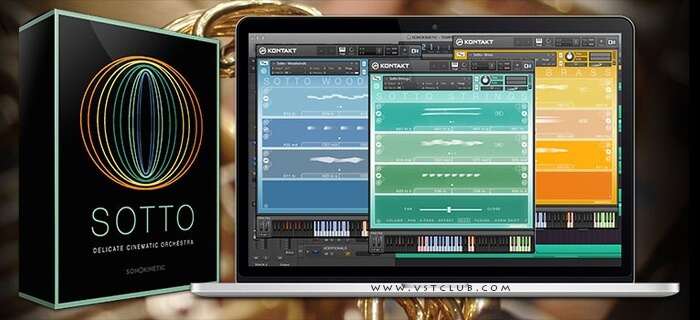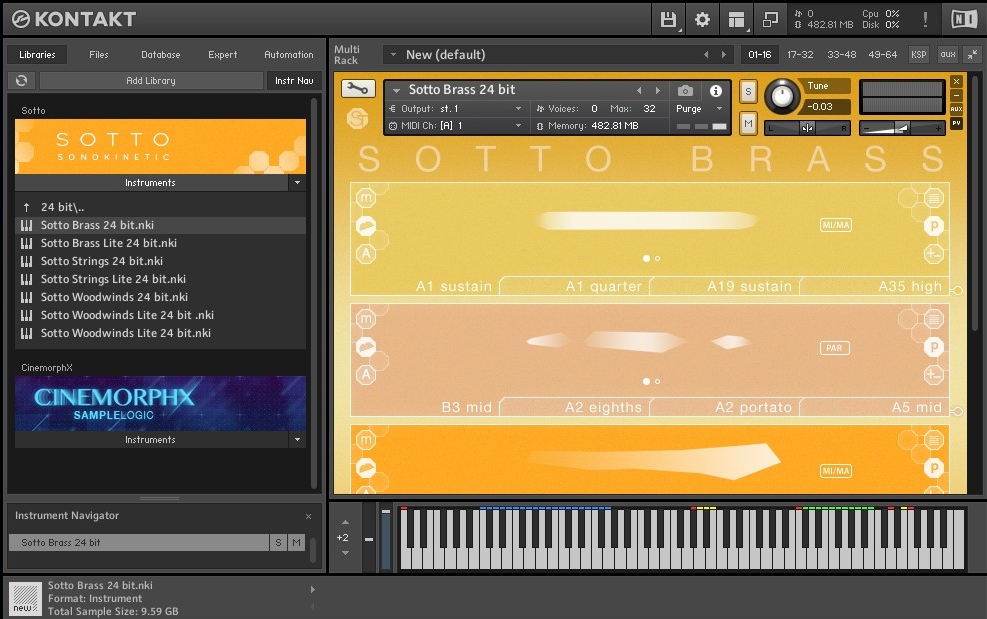Sonokinetic Sotto 24BiT KONTAKT

“Delicate Orchestral Sampling”
Introduction
Today we are going to have a look at “SOTTO”. An awesome orchestral sample library for Kontakt, by Sonokinetic, that is a little bit different than what you might be used to.
As far as orchestral libraries go, “SOTTO” is on the less pricey side and offers some features that I haven’t seen in other orchestral libraries so far. The most obvious one, being that it is a phrase based library. Meaning you can’t actually play single notes with it.
Instead, you get to choose up to 3 phrases, and then the library placed them for you as you press any major or minor triad chord. This might sound very limiting at first but combined with “SOTTO’s” other features it is actually quite useful – it sounds surprisingly good, and can save a lot of time. Sound wise it is more on the softer side of orchestral sound, which I found refreshing and useful. After all most orchestral sample libraries like to showcase their “Bombastic” and “Big” character these days, when small gentle sound is needed as much in almost all Productions.
Some other great features, that give “SOTTO” it’s great work-flow, are the easy-to-understand interface, the tempo sinking features, it’s MIDI ‘drag and drop’ feature, and the harmonic shift capabilities.
If compared directly to other orchestral libraries it seems like this one would just let you play a fixed number of loops, and sacrifice most of the flexibility for it. But after taking a closer look, it becomes obvious, that “SOTTO” takes a completely different approach to the idea of sampling libraries, and can therefore hardly be compared with others.
If you’d like to see a demonstration had over to the Sonokinetic website (link at the end of our review). They have some great tutorials explaining the specific features of their library.
Overview
“SOTTO” includes separate instrument banks for Woodwinds, Brass, and Strings. All of these are ensemble patches, in which you choose the section by selecting a pattern from the “high”, “mid” or “low” category. It takes a little bit of time to get used to working with phrases. But I found it especially useful for quick sketch-ups, or to get started on a blank page. The phrases offer a lot of inspiration, and the randomize function helps with that. It does feel a little similar to loops, but as you will quickly discover, the phrases offer a lot more flexibility and versatility than just a simple loop.
All included phrases are in 4/4 meter, but time stretch decently enough to most common time signatures. The samples are available in 24 bit and 16-bit, there is an overall of 37,000+ samples, that take a hefty 60 GB hard drive. The samples root from 52 string players, 12 woodwind players, and 15 brass players being recorded. This library supports the NKS 1.5 format for those of you that own “Komplete Kontrol” keyboards.
How it works
So let’s have a look at the interface and some specific functions. The first three sections you can see, contain the phrases. The Phrases are visualized with these white cloud-like structures. They visualize rhythm, structure, and tonal movement. Each phrase container has 4 separate sub-sections, which can be loaded with different phrases and triggered via key-switch, to form progressions.
Sonokinetic Sotto
The 3 small white dots you can see at the top phrase, show that there is in this particular case, 3 variations for this phrase. This varies from phrase to phrase, and doesn’t get displayed within the phrase selection.
A lot of the features really need fiddling, and finding out how to best utilize them. Especially the placement of MIDI notes, as they have to be slightly offbeat to compensate for the build and attack. But once you get the hang of it is quite fun.
The three icons visible on the left side of each phrase window, are from top to bottom:
The mute function – enabling us to mute phrases separately or create buildups by on muting them one after the other.
The mod-wheel control – Which gives us the ability to control the volume of any phrase via the mod–wheel.
And the phrase tempo – which by default is set to “A”, for automatic detection of host-tempo. But can also be set to single, double, or half tempo.

The 3 icons on the right side, from top to bottom, provide access to:
The MIDI score view.
The purge sample option, which is really handy to save RAM, if you’re on an older system.
The harmonic shift “on/off“ switch.
…I will cover the details of some of these functions a little further down.
On the lowest field is our Option menu. From here we can access:
The volume for each phrase, which can be adjusted separately for the tail.
The panning for each phrase.
The cross-fade speed for each phrase.
The tempo offset control: which allows us to set a positive or negative offset to a maximum of one bar on each individual phrase.
The microphone settings, where we can choose from 4 different microphone positions and mix in between them.
The tuning settings.
The harmonic shift matrix, which lets us control the harmonic shift pattern for our key switches.
Harmonic Shift & Midi Score View
These are 2 features that I want to bring special attention to. Let’s first have a look at the harmonic shift function.
Harmonic shift allows us to shift any phrase were playing while holding the same chord. To do this we use the keys of the octave indicated in green on our keyboard. Pressing one of the keys of the indicated octave will shift our phrase harmonically in a major or minor direction by adding the indicated interval.
For even more control over the harmonic shifting, or to see how exactly the shifting occurs, we can open the options window on the harmonic shift tab. Here we find something that looks a little bit like a DNA string. This is the harmonic shifting matrix of “SOTTO”. Here we can alter the major or minor pattern of the harmonic shifting. When pressing one of the harmonic shift keys, we can now also see in the options window how exactly our court is shifted.
The MIDI Score View provides much more functionality than I originally expected. Whenever you switch to this view, it will display the notation of the phrase you have currently selected. Above that, you’ll find an octave of the keyboard, which will allow you to alter the key in which the notation is displayed. While this is all nice and good, it seems somewhat redundant in the library where you can play single notes.
But here is the actual highlight of this feature. After altering the notation however you desire, you can actually just drag-and-drop it over into an empty channel of your DAW, and use it however you like. This is especially helpful when combining phrases with instruments of other libraries and can also be a great time saver for developing a quick sketch of a musical idea.
Conclusion
Looking at this library after getting used it for a while and figuring out how it works, leads me to this opinion: it is, like I said in the beginning, a completely different approach to an orchestral library, and therefore feels a little bit unconventional at the beginning. But it is easy to learn and to get into, and once you’re familiar it can save a great deal of time and work. Maybe not necessarily what your final mix will sound like, but a good point to start.
Considering its relatively low price point and its accessibility, I would say it’s a pretty good starting point, especially for newcomers who are starting to build their arsenal, and need to pump out a lot of material really quickly.
Sound quality wise it is decent, not quite up to par with the most expensive libraries out there, but not too far below that, and I understand that’s how it is intended. It does sound gentle and lush exactly the way it is advertised, but is still absolutely capable of producing a lot of character, especially when utilizing breath control, panning, cross fading, and the other features.
Home page: https://www.sonokinetic.net/products/classical/sotto/
Download (Only for VIP members)
http://vstclub.com/forum/230-125411-1
|  Home
Home  Registration
Registration Sign In
Sign In
 Home
Home  Registration
Registration Sign In
Sign In

